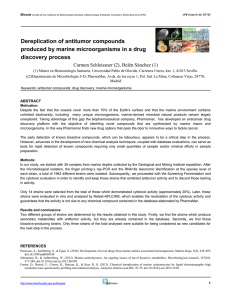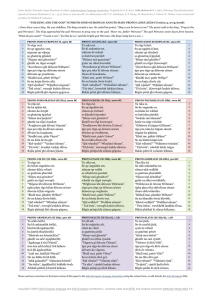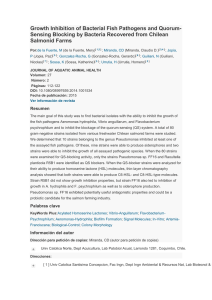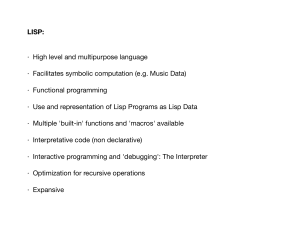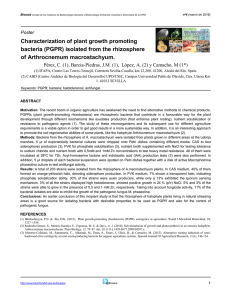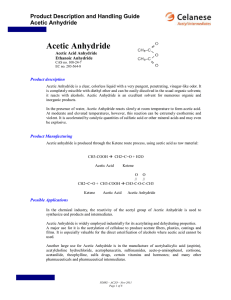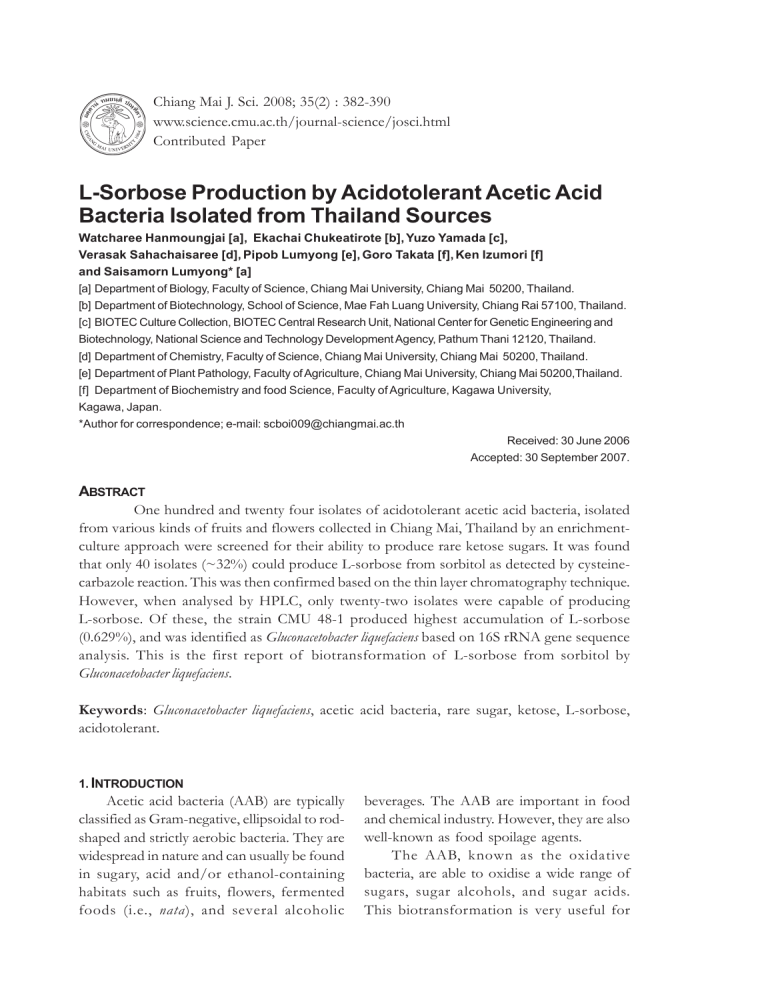
382 Chiang Mai J. Sci. 2008; 35(2) Chiang Mai J. Sci. 2008; 35(2) : 382-390 www.science.cmu.ac.th/journal-science/josci.html Contributed Paper L-Sorbose Production by Acidotolerant Acetic Acid Bacteria Isolated from Thailand Sources Watcharee Hanmoungjai [a], Ekachai Chukeatirote [b], Yuzo Yamada [c], Verasak Sahachaisaree [d], Pipob Lumyong [e], Goro Takata [f], Ken Izumori [f] and Saisamorn Lumyong* [a] [a] Department of Biology, Faculty of Science, Chiang Mai University, Chiang Mai 50200, Thailand. [b] Department of Biotechnology, School of Science, Mae Fah Luang University, Chiang Rai 57100, Thailand. [c] BIOTEC Culture Collection, BIOTEC Central Research Unit, National Center for Genetic Engineering and Biotechnology, National Science and Technology Development Agency, Pathum Thani 12120, Thailand. [d] Department of Chemistry, Faculty of Science, Chiang Mai University, Chiang Mai 50200, Thailand. [e] Department of Plant Pathology, Faculty of Agriculture, Chiang Mai University, Chiang Mai 50200,Thailand. [f] Department of Biochemistry and food Science, Faculty of Agriculture, Kagawa University, Kagawa, Japan. *Author for correspondence; e-mail: scboi009@chiangmai.ac.th Received: 30 June 2006 Accepted: 30 September 2007. ABSTRACT One hundred and twenty four isolates of acidotolerant acetic acid bacteria, isolated from various kinds of fruits and flowers collected in Chiang Mai, Thailand by an enrichmentculture approach were screened for their ability to produce rare ketose sugars. It was found that only 40 isolates (~32%) could produce L-sorbose from sorbitol as detected by cysteinecarbazole reaction. This was then confirmed based on the thin layer chromatography technique. However, when analysed by HPLC, only twenty-two isolates were capable of producing L-sorbose. Of these, the strain CMU 48-1 produced highest accumulation of L-sorbose (0.629%), and was identified as Gluconacetobacter liquefaciens based on 16S rRNA gene sequence analysis. This is the first report of biotransformation of L-sorbose from sorbitol by Gluconacetobacter liquefaciens. Keywords: Gluconacetobacter liquefaciens, acetic acid bacteria, rare sugar, ketose, L-sorbose, acidotolerant. 1. INTRODUCTION Acetic acid bacteria (AAB) are typically classified as Gram-negative, ellipsoidal to rodshaped and strictly aerobic bacteria. They are widespread in nature and can usually be found in sugary, acid and/or ethanol-containing habitats such as fruits, flowers, fermented foods (i.e., nata), and several alcoholic beverages. The AAB are important in food and chemical industry. However, they are also well-known as food spoilage agents. The AAB, known as the oxidative bacteria, are able to oxidise a wide range of sugars, sugar alcohols, and sugar acids. This biotransformation is very useful for Chiang Mai J. Sci. 2008; 35(2) production of rare monosaccharides which are important in medicine and food industry [1]. For example, Acetobacter aceti IFO3281 can be used to prepare D-xylulose from Darabitol [2]; L-ribulose, L-ribose and Larabinose from ribitol [3]. The bioconversion of D-sorbitol to L-sorbose is carried out industrially by Gluconobacter suboxydans ATCC621 [4,5]. L-Psicose is produced from allitol using Gluconobacter frateurii IFO3254 [6]. Production of tagatose, a ketohexose C4fructose epimer, from D-galactitol by Gluconobacter oxydans DSM2343 has also been reported [7]. L-sorbose is of great importance as the starting material for industrial production of L-ascorbic acid through, the so-called “Reichstein method”. Besides, application of L-sorbose as a precursor to synthesise glycosidase inhibitor, 1-deoxygalactonojirimycin, has been reported [8]. Currently, selective oxidation of D-sorbitol to L-sorbose is performed by Gluconobacter oxidans on an industrial scale [6]. In this paper, several AAB isolated from flowers and fruits collected in Chiang Mai, Thailand were characterised for their ability to produce rare ketoses, L-sorbose. 2. MATERIALS AND METHODS 2.1 Acetic Acid Bacteria Reference Strains The AAB used in this study as reference strains for identification were as follows: Acetobacter aceti BCC12455 (IFO14818T), Gluconobacter oxydans BCC12337 (IFO14819T), Gluconobacter frateurii BCC12341, Gluconobacter cerinus BCC12339, Gluconobacter asaii BCC 12302, Gluconobacter hensenii BCC12272, Gluconacetobacter liquefaciens BCC12274 (IFO 12388 T ), Asaia bogorensis BCC12264 (IFO16594T) and Asaia siamensis BCC12268 (IFO16457T). These microorganisms were obtained from BIOTEC culture collection (BCC), Pathumthani, Thailand. 383 2.2 Isolation of Acetic Acid Bacteria AAB were preliminary screened and isolated from flowers and fruits collected in Chiang Mai by using four different enrichment culture broths: Glucose-ethanol-acetic acid medium (5% glucose, 0.5% ethanol, 0.3% peptone, 0.3% yeast extract and 0.3% (v/v) acetic acid); Glucose-ethanol medium (1.5% glucose, 0.5% ethanol, 0.3% peptone and 0.3% yeast extract); Sorbitol medium (2% sorbitol, 0.3% peptone and 0.3% yeast extract); Sucrose-acetic acid medium (2% sucrose, 0.3% peptone, 0.3% yeast extract and 0.3% (v/v) acetic acid ). Prior to sterilisation, the pH of these media were adjusted to 3.5 with HCl. All ripening fruits and fresh flowers parts: petal, anther or ovaries, were sliced into small pieces (1 x 1 cm2) and were then added into those media to enrich the bacterial growth at room temperature for 4 days. Zero point two ml supernatant of enrichment culture was spread on agar media. Morphologically distinct bacterial colonies appeared on the plates were transferred to the new media and subsequently prepared as pure cultures of isolated acetic acid bacterial strains. The isolated bacteria were restreaked on the glucoseethanol-calcium carbonate agar plates (2% glucose, 0.5% ethanol, 0.3% peptone, 0.3% yeast extract, 0.7% calcium carbonate and 1.2% agar). The acetic acid bacteria were preliminary identified and selected based on the presence of clear zones around colonies on the agar plates. All bacteria strain isolates were cultured at 30oC on the glucose-ethanolcalcium carbonate agar slants and maintained at 4oC until further use. 2.3 Characterisation and Identification of Acetic Acid Bacteria The AAB isolated were then characterised based on their morphology, physiology and biochemistry compared with the reference strains as previously described [9-11]. Growth 384 in the presence of 0.35% acetic acid (v/v) was also examined at pH 3.5 [12]. Oxidation of acetate and lactate to CO2 and H 2O were examined by Leifson’s method [9]. Oxidation/ Fermentation test was done by the use of Hugh and Leifson’s medium that contained 1% glucose [13]. Dihydroxyacetone formation was detected by using Fehling’s solution. Acid productions from different carbon sources were tested as described by Asai et al. [9]. 2.4 Determination of L-sorbose Production To determine L-sorbose production, the AAB (OD 0.2) were grown aerobically with continuous agitation (70 rpm) for 24-48 h at room temperature in the basal medium (PYS: 0.5% polypeptone, 0.5% yeast extract, 0.5% NaCl) containing 1% D-sorbitol. After incubation for 48 h at room temperature, the supernatant (OD 0.8) was collected and used to measure the ketose production (i.e., L-sorbose) based on the cysteine-carbazole reaction [14]. The thin layer chromatography (TLC) technique was subsequently used to confirm the sorbose production. The chromatographic developments were carried out using the TLC plates of silica gel 60 F254 (20 U 20 cm2 glass plates) in a rectangular chamber (10 U 24 U 24 cm3). The solvent system employed was phenol-water (4:1). The supernatant samples and standard ketose sugars (D-fructose and L-sorbose) were spotted (5 μl) on the TLC plate; the spotted TLC plate was then placed into the chamber. The development of the chromatogram was then allowed to proceed and the TLC plate was finally sprayed with indicator solution composed of 3% p-anisidine in butanol to reveal the ketose sugars. To accurately determine the concentrations of L-sorbose, further analysis was undertaken from selected strains grown on Chiang Mai J. Sci. 2008; 35(2) the PYS medium with 1% or 3% D-sorbitol (inoculum at OD 0.8, incubation for 48 h at room temperature) using HPLC (Nihonbunko HPLC 880 PU liquid chromatography, Shimadzu RID-6A refractive index detector, Shimadzu LC-6A pump, Shimadzu CTO-6A oven, Shimadzu SCL-6B controller and Shimadzu CR-6A Chromatopac) using a Phenomenex Rezex RCM monosaccharide HPLC column on a Shimadzu model RID-6A liquid chromatograph. The separations were achieved at 80oC using deionised water at a flow rate of 0.5 ml min-1. 2.5. Identification of Aacetic Acid Bacteria Using 16S rRNA Gene Sequence Analysis Genomic DNA was isolated from the acetic acid bacteria using the modified method of Marmur [15]. DNA fragment specific for the 16S rDNA was amplified by PCR as described previously [12,16]. Two primers, 20F (5’GAGTTTGATCCTGGCTCAG-3’; position 9-27) and 1500R (5’-GTTACCTTG TTACGACTT-3’; position 1509-1492), were used. The numbers of position in the rDNA gene fragments were based on the Escherichia coli numbering system (accession number V00348) [17]. The condition used for thermal cycling was as follows: denaturation at 94oC for 3 min, followed by 25 cycles of denaturation at 94oC for 1 min, annealing at 50oC for 1 min and extension at 72oC for 2 min. The amplified 16S rRNA fragment was then separated by agarose gel electrophoresis and purified using a QIAquick gel extraction kit (QIAGEN, Germany). Amplified 16S rDNA were directly sequenced using an ABI PRISM BigDye Terminator cycle sequencing ready reaction kit on an ABI PRISM model 310 Genetic Analyser. The following six primers were used: 20F, 1500R, 520F (5’-CAGCAGCCGCGG Chiang Mai J. Sci. 2008; 35(2) TAATAC-3’; positions 519-536), 520R ( 5 ’ - G TAT TAC C G C G G C TG C T G - 3 ’ ; positions 536-519), 920F (5’-AAACTCAAAT GAATTGACGG-3’; positions 907-926) and 920R (5’-CCGTCAATTCATTTGAGTTT3’; positions 926-907). Multiple alignments of the sequences obtained in comparison with those of microbial reference strains [18] were then carried out with the program CLUSTAL W 1.74 [19]. The distance matrices for the aligned sequences were calculated by the twoparameter method of Kimura [20]. The neighbour-joining methods were used for constructing a phylogenetic tree [21]. The robustness for individual branches was estimated by bootstrapping with 1,000 replicates [22]. 3. RESULTS AND DISCUSSION In the past years, information relevant to the AAB diversity is scarce because of most studies were emphasised on similar sample sources. However, it is now well recognised that the AAB group is so diversed than one ever thought. Currently, nine Genera of the AAB are documented namely Acetobacter, Gluconobacter, Gluconacetobacter, Acidomonas, Asaia, Kozakia, Swaminathania, Saccharibacter, and Neoasaia [23]; these are expected to increase due to detailed analyses on their taxonomy. Many new AAB species have been isolated from unique sources such as tropical flowers and fruits [23, 24]. In this present work, various kinds of fruits and flowers collected locally in Chiang Mai, Thailand, were used as sources for screening the AAB and a total of 124 of the AAB strains were obtained. The isolation procedure was performed with four different enrichment media in which the results obtained were heterogenous in terms of types and numbers of the AAB (data not shown). This further confir ms the fastidious 385 characteristics of this particular microbial group. On this basis, it therefore suggests that the AAB isolates could only be a part of the whole bacterial population. All AAB isolated were Gram-negative, rod-shaped aerobes and grew well at pH 3.5. They were motile and produced a water-soluble brown pigment when cultured in the glucose-ethanol medium supplement with calcium carbonate. Although most colonies were white, some produced distinct colour pigments such as pink. All isolates were able to produce acid from D-glucose, D-mannose, D-galactose, D-xylose, L-arabinose, D-mannitol, glycerol and ethanol but not from D-fructose, L-sorbose, D-arabinose, D-sorbitol, sucrose and maltose [25]. These AAB strains were then tested for their ability to produce L-sorbose. Initial screening was undertaken based on the cysteine-carbazole method. This assay is rapid and simple in determining the presence of ketoses as observed by the purplish colour development. The sugar quantity can also be estimated based on the standard graph of a series of known concentration of the ketoses tested. It was found that 40 isolates (~32%) were capable of synthesising L-sorbose by this assay. To confirm the results, the TLC technique was introduced. As shown in Figure 1, the existence of L-sorbose could be observed in which the Rf values of D-fructose and L-sorbose were 0.40 and 0.37, respectively. These supernatants were then subjected to further analysis by HPLC. Our results showed that different AAB strains produced different amounts of L-sorbose. It is interesting to note that, only twenty-two AAB isolates could produce L-sorbose based on HPLC analysis while forty isolates showed positive results when assayed by the cysteinecarbazole method. This emphasises the limited use of the cysteine-carbazole assay, which was incapable of distinguishing fructose from 386 Chiang Mai J. Sci. 2008; 35(2) Figure 1. TLC analysis of ketose sugars. A) D-fructose, B) and K) L-sorbose, C-J) the supernatants from the AAB broth culture (5 μl) of the following strains: CMU To3-2, CMU To3-1, CMU 38G2, CMU R4-1, CMU 48-1, CMU 48-2, CMU Ma-2, and CMU R1-1, respectively. sorbose [5]. Of these AAB tested, five strains namely CMU 48-1, CMU R1-1, CMU 48-2, CMU Ma-2 and CMU R4-1 exhibited high yield (≥0.45 % (v/v) L-sorbose) of L-sorbose (Table 1) and thus selected for further study. The five AAB strains (CMU 48-1, CMU R1-1, CMU 48-2, CMU Ma-2 and CMU R4-1) that produced high L-sorbose were selected for transformation reaction of D-sorbitol. After 24 h incubation each strain in PYS medium containing 1% or 3% D-sorbitol, it was found that conversion of 1% and 3% D-sorbitol to L-sorbose were highest for strain CMU 48-1 with 47.49% and 67.66% in concentration, respectively (Table 2). The HPLC analysis also confirmed that the main product was L-sorbose. To reveal the taxonomic status of these AAB isolates, 16S rDNA sequence analysis was carried out. Initially, their genomic DNA was extracted and the 16S rRNA genes were then amplified using the universal primers [12, 16]. The 16S rRNA gene sequence data obtained were then aligned with those of the AAB type strains available from the GenBank database. The phylogenetic tree as illustrated in Figure 2 was also constructed from evolutionary distance by using the neighbourjoining method [21]. Based on this analysis, the five AAB strains were located in the lineage of the genus Gluconacetobacter and were found to be most identical to G. liquefaciens. It should be noted, however that only the 16S rRNA sequences of the AAB strains CMU 48-1 and CMU Ma-2 were submitted to the nucleotide database and can be accessed as follows: CMU 48-1 (DQ486985) and CMU Ma-2 (DQ486986). Chiang Mai J. Sci. 2008; 35(2) 387 Table 1. Amounts of L-sorbose produced by 5 selected AAB isolates obtained from various plants. The analysis was performed using HPLC. AAB isolates Host plants % (v/v) L-sorbose CMU 48-1 Pineapple (Ananas comosus) 0.629 CMU R1-1 Pineapple (Ananas comosus) 0.597 CMU 48-2 Mango (Mangifera indica) 0.537 CMU Ma-2 Rose apple (Eugenia jambos) 0.502 CMU R4-1 Rose apple (Eugenia jambos) 0.483 Table 2. Amounts of L-sorbose production from 5 selected AAB isolates cultured in basal medium containing 1% and 3% D-sorbitol. The analysis was performed using HPLC. % L-sorbose production in different substrate AAB isolates 1% D-sorbitol 3% D-sorbitol CMU 48-1 47.49 67.66 CMU R1-1 31.50 65.84 CMU 48-2 42.19 65.48 CMU Ma-2 34.63 56.54 CMU R4-1 38.44 34.92 L-sorbose, a key starting material in the industrial manufacture of vitamin C (ascorbic acid), can be produced by bacterial oxidation of D-sorbitol by Acetobacter sp. [26] and Gluconobacter sp. [5]. Srivastava and Lasrado [27] cultivated Acetobacter suboxydans in fedbatch fermentation by feeding nutrients containing sorbitol exponentially and obtained a productivity of 12.6 gl-1h-1. Girdhar and Srivastava [28] also cultivated Acetobacter suboxydans NRRL B72 in fed-batch fermentation using an initial sorbitol concentration of 200 gl-1 and demonstrated a productivity of 17.7 gl-1h-1. The present work cultivated Gluconacetobacter liquefaciens strain CMU 48-1 in batch fermentation containing 10 gl-1 and 30 gl-1 sorbitol yielded productivity of 94 mgl -1 and 134 mgl -1 , which are lower compared to other bacteria that reported by earlier workers. This present study, however, is the first report of the bioconversion of D-sorbitol to L-sorbose by Gluconacetobacter sp. Further study relevant to the metabolic mechanism may offer an alternative to classical L-sorbose synthesis. ACKNOWLEDGEMENTS The authors wish to thank the BIOTEC Culture Collection, Thailand for supplying reference AAB strains. We also would like to acknowledge the Graduate School of Chiang Mai University for financial support. 388 Chiang Mai J. Sci. 2008; 35(2) Figure 2. Phylogenetic relationship based on the 16S rDNA sequence of the AAB strains CMU Ma-2 and CMU 48-1 in comparison with other AAB type strains. Numerals indicate bootstrap values derived from 1,000 replications. Chiang Mai J. Sci. 2008; 35(2) S. Lumyong, P. Lumyong , V. Sahachaisaree and K. Izumori thanks JSPS-NRCT and ISRS Rare sugar project for partial support of this research. 389 REFERENCES [8] Huwig A., Emmel S., Jakel G. and Giffhorn F., Enzymatic synthesis of Ltagatose from galactitil with galactitol dehydrogenase from Rhodobacter spaeroides D. Carbohydrate Res., 1998; 281, 183186. [1] Granstrom T.B., Takata G., Tokuda M. and Izumori K., Izumoring: a novel and complete strategy for bioproduction of rare sugars, J. Biosci. Bioeng., 2004; 97, 8994. [9] Asai T., Iizuka H. and Komagata K., The flagellation and taxonomy of genera Gluconobacter and Acetobacter with reference to the existence of intermediate strains, J. Gen. Appl. Microbiol., 1964; 10, 95-126. [2] Ahmed Z., Production of natural and rare pentoses using microorganisms and their enzymes, Electron, J. Biotechnol., 2001; 4, 103-111. [10] Yamada Y., Okada Y. and Kondo K., Isolation and characterization of “polarly flagellated intermediate strains” in acetic acid bacteria, J. Gen. Appl. Microbiol., 1976; 22, 237-245. [3] Ahmed Z., Shimonishi T., Bhuiyan S.H., Utamura M., Takada G. and Izumori K., Biochemical preparation of L-ribose and L-arabinose from ribitol: a new approach, J. Biosci. Bioeng., 1999; 88, 444448. [4] Rosenberg M., Svitel J., Rosengerova I. and Sturdick E., Optimisation of sorbose production from sorbitol by Gluconobacter oxydans, Acta Biotechnol., 1993; 35, 269-274. [5] Macauley-Patrick S., McNeil B. and Harvey L.M., By-product formation in the D-sorbitol to L-sorbose biotransformation by Gluconobacter suboxydans ATCC 621 in batch and continuous cultures, Process Biochem., 2005; 40, 21132122. [6] Takeshita K., Shimonshi T. and Izumori K., Production of L-psicose from allitol by Gluconobacter frateurii IFO 3254, J. Ferment. Bioeng., 1996; 81, 212-215. [7] Manzoni M., Rollini M. and Bergomi S., Biotransformation of D-galactitol to tagatose by acetic acid bacteria, Process Biochem., 2001; 36, 971-977. [11] Yamada Y., Hosono R., Lisdiyanti P., Widyastuti Y., Saono S., Uchimura T. and Komagata K., Identification of acetic acid bacteria isolated from Indonesian sources, especially of isolates classified in the genus Gluconobacter, J. Gen. Appl. Microbiol., 1999; 45, 23-28. [12] Yamada Y., Katsura K., Kawasaki H., Widyastuti Y., Saono S., Seki T., Uchimura T. and Komagata K., Asaia bogorensis gen. nov., sp. nov., an unusual acetic acid bacterium in the a-Proteobacteria, Int. J. Syst. Bacteriol., 2000; 50, 823-829. [13] Smibert R.M. and Krieg N.R., Phenotypic characterization, In: Methods for General and Molecular Bacteriology (Gerhardt P., Murray R.G.E., Wood W.A. and Krieg N.R., Eds.), ASM Press, Washington, D.C., 1994; 607-654. [14] Dishe Z. and Borenfreuind E., A new spectrophotometric method for the detection of keto sugars and trioses, J. Biol. Chem., 1951; 192, 583-587. 390 Chiang Mai J. Sci. 2008; 35(2) [15] Marmur J., A procedure for the isolation of deoxyribonucleic acid from microorganisms, J. Mol. Biol., 1961; 3, 208-218. [22] Felsenstein J., Confidence limits on phylogenies: an approach using the bootstrap, Evolution, 1985; 39, 783-791. [16] Kawasaki H., Hoshino Y., Hirata A. and Yamasato K., Is intracytoplasmic membrane structure a generic criterion? It does not coincide with phylogenetic interrelationships among photosynthetic purple nonsulfur bacteria, Arch. Microbiol., 1993; 160, 358-362. [23] Yukphan P., Malimas T., Potacharoen W., Tanasupawat S., Tanticharoen M. and Yamada Y., Neoasaia chiangmaiensis gen. nov., sp. nov., a novel osmotolerant acetic acid bacterium in the a-Proteo-bacteria, J. Gen. Appl. Microbiol., 2005; 51, 301-311. [17] Brosius J., Dull T.J., Sleeter D.D. and Noller H.F., Gene organization and primary structure of a ribosomal RNA operon from Escherichic coli, J. Mol. Biol., 1981; 148, 107-127. [18] Benson D.A., Karsch-Mizrachi I., Lipman D.J., Ostell J. and Wheeler D.L., GenBank, Nucl. Acids Res., 2006; 34, D16D20. [19] Thomson J.D., Higgins D.G. and Gibson T.J., The CLUSTAL W: improving the sensitivity of progressive multiple sequence alignment through sequence weighting, position-specific gap penalties and weight matrix choice, Nucl. Acids Res., 1994; 22, 4673-4680. [20] Kimura M., A simple method for estimating evolutionary rates of base substitutions through comparative studies of nucleotide sequences, J. Mol. Evol., 1980; 16, 111-120. [21] Saitou N. and Nei M., The neighborjoining method: a new method for reconstructing phylogenetic trees, Mol. Biol. Evol., 1987; 4, 406-425. [24] Yukphan P., Potacharoen W., Tanasupawat S., Tanticharoen M. and Yamada Y., Asaia krungthepensis sp. nov., an acetic acid bacterium in the a-Proteobacteria, Int. J. Syst. Evol. Microbiol., 2004; 54, 313316. [25] Hanmoungjai W., Chukeatirote E., Pathom-aree W., Yamada Y. and Lumyong S., Identification of acidotolerant acetic acid bacteria isolated from Thailand sources, Res. J. Microbiol., 2007; 2, 194-197. [26] Itoh H. and Izumori K., Enzymatic production of L-tagatose and L-fructose from L-sorbose and L-psicose, respectively, J. Ferment. Bioeng., 1996; 81, 351-353. [27] Srivastava A.K. and Lasrado P.R., Fed batch sorbitol to sorbose fermentation by A. suboxydans, Bioproc. Eng., 1998; 18, 457-461. [28] Girdhar R. and Srivastava A.K., Fedbatch cultivation of Acetobacter suboxydans for the microbial oxidation of Dsorbitol to L-sorbose, Bioproc. Eng., 2000; 23, 575-577.
